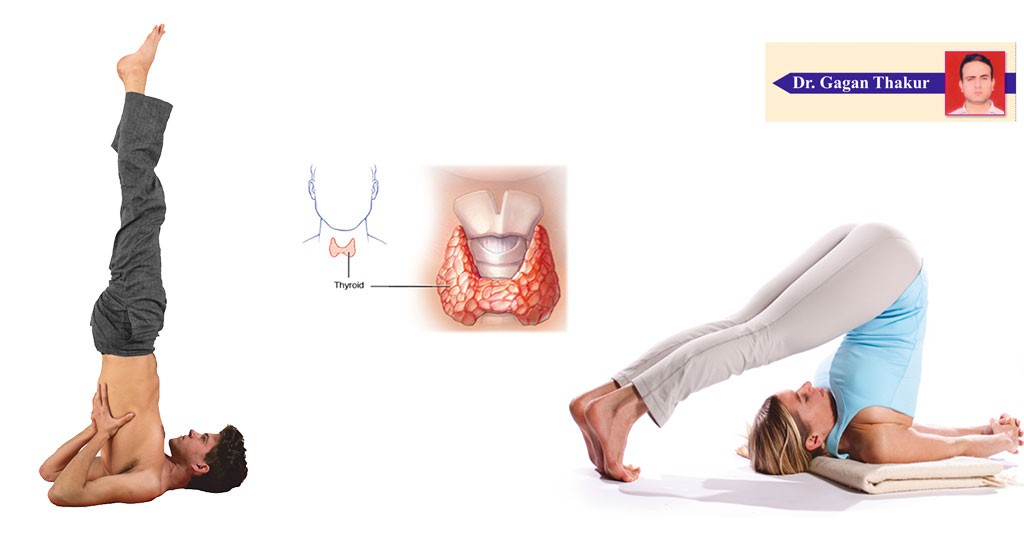The thyroid gland is a small gland that lies just under the skin below the adam’s apple in the neck. It has two halves which are connected by isthmus in the middle giving thyroid gland the shape of a bow tie. Normally, the thyroid gland cannot be seen and can barely be felt. If it becomes abnormal it is enlarged and can be felt easily.
The thyroid gland is a small gland that lies just under the skin below the adam’s apple in the neck. It has two halves which are connected by isthmus in the middle giving thyroid gland the shape of a bow tie. Normally, the thyroid gland cannot be seen and can barely be felt. If it becomes abnormal it is enlarged and can be felt easily. Thyroid gland is important for us as it makes two hormones that are secreted into the blood: Thyroxine (T4) and triodothyronine (T3). These hormones are necessary for all the cells in body to work normally. Production of T4 and T3 is again dependant on a stimulating hormone called thyroid stimulating hormone (TSH) which is released by a master endocrine gland, pituitary. Thus levels T4, T3 and TSH in blood are responsible for thyroid health. If levels of T4 and T3 are raised with supressed TSH, then the condition is called hyperthyroidism. It is characterized by nervousness, irritability, inability to relax, feeling of warm, heat intolerance, increased sweating, palpitation, increased frequency of bowel movements, increased appetite and weight loss etc.
Hypothyroidism is a condition that develops when the thyroid gland is unable to produce enough T3 and T4. The symptoms of hypothyroidism vary greatly from one person to another. They can include tiredness, weight gain, feeling of cold, slowing down physically and mentally, dry skin, loss of hair, muscle weakness, puffiness, depression, hearing loss and constipation. Women can develop heavy periods or they may lose them altogether.
How Common Is Hypothyroidism
Hypothyroidism is very common. It affects women more frequently than men and usually at around middle age. Hypothyroidism affects approximately 1 in 1000 men and 18 in 1000 women. Subclinical hypothyroidism is much more common and affects approximately 28 in 1000 men and 75 in 1000 women.
One of the most important facts with respect to thyroid diseases is that in most of the cases they are diagnosed very late. So, there is presentation of various complaints related to various organ systems. Only careful examination can reveal that all these features are related to the abnormal functioning of thyroid gland.
In this issue we shall have a close look over yogasana and pranayama managing hypothyroidism.
A little yoga practice daily can add to thyroid wellness and can keep a lot of diseases away from our body. Yogic asanas like Sarvangasana, Halasana, Matsyasana, Naukasana, Ushtrasana, Bhujangasana and Suryanamaskar are some of them. They focus on stimulating the thyroid and improve the overall thyroid health. One important thing which is to be kept in mind is that remaining in the pose for maximum time is very important and one should follow the basic rule of go slow and listen to your body. Be gentle and easy with yourself.
Sarvangasana
(Shoulder stand)
Sarvangasana is one of the most important asanas that is suggested to treat thyroid ailments. It is an inversion and stimulates blood flow to the glands. It is believed to have a positive effect on the efficiency of the thyroid gland.
Steps
Lie flat on the back with arms along side of the body and palms facing down. Press the palms and arms for lifting both legs to ninety degrees while inhaling. Now exhale slowly and bring legs over the head. Bring your hands to lower back to support the body. Try to raise the legs straight up towards the ceiling such that spine and hips are in one line. Keep the chin tucked into the chest. Remain in this pose as long as it feels comfortable. Now while inhaling, slowly roll the spine down vertebrae by vertebrae and release the pose.
Be careful of the neck and back during this pose and discontinue if have feel any discomfort.
Halasana
(Plow pose)
Halasana is very beneficial pose for thyroid health. It gives positive health to thyroid gland and whole spine.
Steps
Lie flat on back and arms alongside the body and palms facing down. Now, inhale and lift the legs up to ninety degrees. After this, bring the legs over the head while exhaling. Try to touch floor with toes. Remain in this pose as long as it is comfortable, inhale and exhale calmly. While releasing the pose, slowly inhale and lift the legs up and bring back legs to floor and exhale.
This pose may be difficult for beginners so they may require additional help. Care must be taken if there is any problem related to spine.
Matsyasana
(Fish pose)
Fish pose is another important asana which can remarkably improve the functioning of thyroid gland. It is also beneficial for patients suffering from stress, anxiety, obesity and diabetes.
Steps
Sit on buttocks with legs extended in front. Put the palms down and fingers facing toward the toes. Now draw elbows in such a way that chest opens up, lean back on to forearms and elbows. Open the chest as much as possible and press into arms to stay lifted. Now drop the head gently. Release the pose by lifting the head, releasing the hands and lying down on the back. Take a few deep breaths and repeat the steps.
Viprit Karni
(Legs-up-the-wall pose)
Viprit Karni or legs up the wall pose, is a restorative inversion which does not put pressure on the neck and a suitable choice for most of the patients suffering from thyroid dysfunction.
Steps
Sit in an open space near a wall in such a way that feet are on the floor spread in front of you. Now exhale and lie on the back making sure that the back of legs press against the wall and sole of feet face upwards. Be in a comfortable position and place buttocks a little near the wall or press them against the wall. With back and head resting on the floor, make an angle of 90 degree. We can also use our hands to support our body. Keep head and neck in a neutral position and soften throat and face. Close the eyes and breathe gently. Hold the position for five to ten minutes. While releasing gently, roll to any one side and lie down for a few seconds before sitting up.
Cat-Cow pose
This asana is also very beneficial for patients suffering from thyroid dysfunction. The fluid motion in cat -cow pose is believed to stimulate thyroid gland. Drawing chin into the chest and then exposing neck improves the circulation to the area and is thus very helpful for thyroid function.
Steps
Come on to all fours with wrist directly under shoulders and knees underneath the hips. Make sure that weight of body should full on equal on all fours. Now, inhale and let belly fill with air and drop towards the mat. Further look up towards the ceiling and lengthen neck and throat. After few seconds, exhale and draw navel into spine. Tuck the chin into chest and lift and then round the spine towards ceiling. Continue this flowing movement for few seconds. Release the pose and lie down in shavasana for ten minutes to reap maximum benefits.
Bhujangasana
(Cobra pose)
Bhujangasana brings a lot of stimulation to thyroid gland. It is a comparatively easy pose and can be practised by a person of any age group.
Steps
Lie flat on stomach with hands underneath shoulders and palms pressing down. Slowly bring elbows into the side of the chest. Now, inhale and slowly lift head, chest and shoulders keeping a slight bend in elbows. Remain in the position for a while and feel the extended neck. After a few seconds start exhaling and bring back forehead, chest and shoulders on the ground. Now take a few deep breaths and repeat the asana.
Pranayama
Apart from yogic asana, pranayama is also very helpful for thyroid patients. It not only increases oxygenation of the body but also helps to combat mal effects of stress on thyroid. The most effective pranayama for thyroid problems is Ujjayi Pranayama. It works on the neck area, reducing hypothyroidism.
Steps
Sit in a comfortable yoga meditative pose like sukhasana. Draw in a long, deep breath, using both nostrils. Now exhale thoroughly through your mouth, producing a ‘ h h a a a’ sound from your throat. Repeat the exercise 5-10 times, in one go.
Apart from Ujjayi Pranayama, Kapalbhati and Anuloma Viloma can also be practised to gain more benefits.
Associate Professor,
Department of Swasthvritta,
Dayanand Ayurvedic College, Jalandhar. 9465466589, ashugag21@gmail.com







 Dec 2024
Dec 2024
 May 2024
May 2024
 September 2022
September 2022
 April 2022
April 2022
 October 2020
October 2020
 Jan 2020
Jan 2020
 June 2019
June 2019
 January-February 2019
January-February 2019
 Augest-September
Augest-September
 April 2018
April 2018
 November 2017
November 2017
 June 2017
June 2017
 November 2016
November 2016
 September 2015
September 2015
 March 2015
March 2015
 July 2014
July 2014
 January 2014
January 2014
 July2013
July2013
 March 2013
March 2013
 May 2012
May 2012
 May 2011
May 2011
 Sep 2010
Sep 2010
 Jun 2010
Jun 2010
 Feb 2010
Feb 2010
 December 2009
December 2009
 August 2009
August 2009
 June 2009
June 2009
 Feb 2009
Feb 2009
 December 2008
December 2008
 October 2008
October 2008
 March 2008
March 2008
 July 2008
July 2008
 May 2008
May 2008